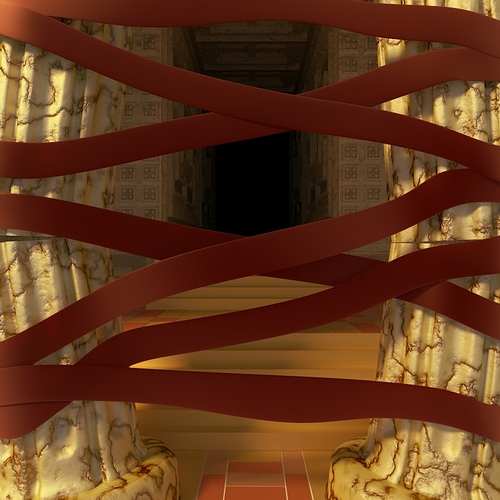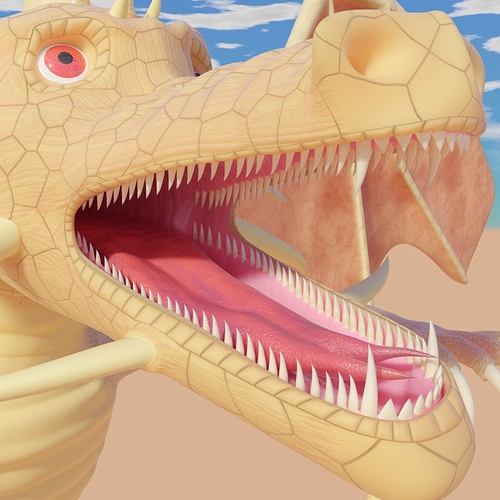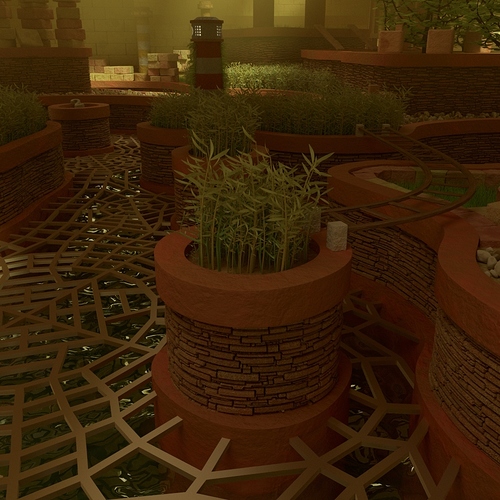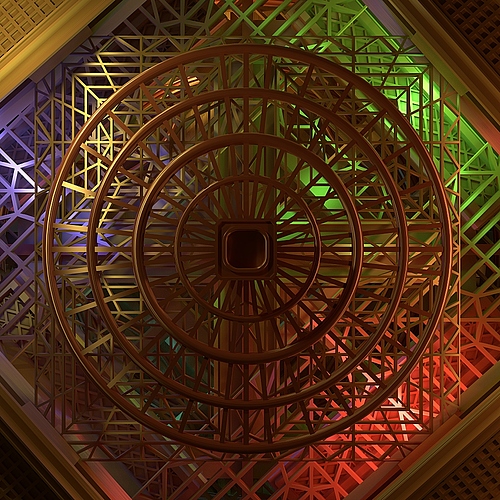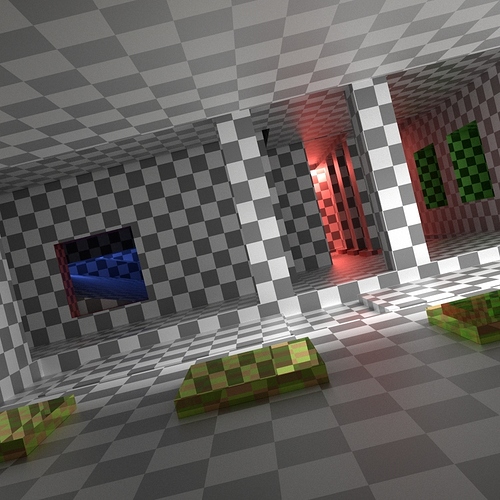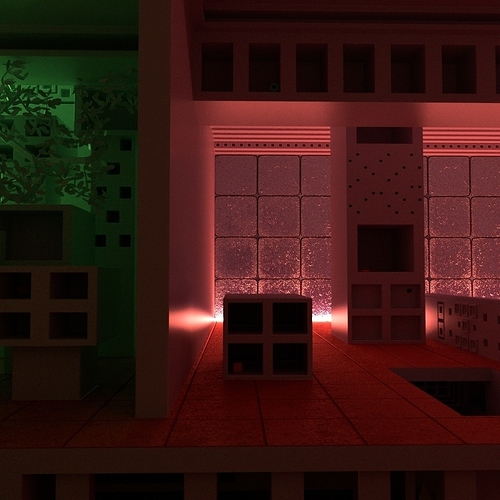I like I like I like! Simply Orange is my favourite.
Thank you all.
A Whole Lotta Red Tape; - I wasn’t really going for an overt political message in this scene (I usually work for creativity, not advocacy or social justice), but I realize that interpretations can go a number of ways here. That could range from someone clumsily wanting to keep the columns together with tape to the inherent inefficiencies of large-scale bureaucracy.
The Artists Vacation Home; - Another remix and altered idea from the days of using BI, I already made an abstract ‘artists’ house’, so I decided to go one step beyond that and make an even fancier vacation home concept (more detail and more realism). It also fits with the idea that a lot of people have in that a vacation home should feel like a getaway and not just another place of ordinary living.
Route Pi; - Made in the early days of Cycles as a usable product (ie. when it was still a branch). Even back then it could be used to create interesting ideas, but I did have to fight with shader node bugs and the limited RAM of my old machine’s 32 bit OS, so in a way I wished I could’ve placed more detail in it, but overall turned out not too shabby. I guess the concept itself is easy to get, as route Pi itself just goes in a circle.
Finished Vases series; - These are the first three of a series of four still-life images that feature a finished vase with a glossy finish. The idea of the first image was simple, which is showcase a common object as seen in classic still-life paintings. This also, at the time, also received some semi-precise brightening work in post-production which I needed to make sure that it didn’t affect the area in the window.
The other images share the same prefix of ‘Finished Vases’ (unlike the first which is just that), with the intention that the environments would have a contrast to them across the series with the blue vase image being contemporary and the red one being more naturalistic (hence the names ‘Contemporary Blue’ and ‘Naturally Red’, the latter also being an image I struggled to render because of memory limits on my old machine).
And the last one, which pretty much combines the material of the two (under the name of ‘Palatial Multicolor’). One of the last images rendered with my old machine (and one of the first to get a detail bump thanks to the new one).
man this are nice render i like it so much could you show me how to do like that render ?
I really like the last post on #19. The one you referred to as surreal. That is a really cool image. Camera angle is just right. Is that a slinky on the steps? If so, awesome!
Yes, that is a slinky (a type of object that’s been much easier to make thanks to Bmesh) ![]()
When I say easier to make even though it makes use of proportional editing, I’m meaning that before Bmesh, the connectivity-based option only worked to a certain point because the architecture did not have built-in information for that.
man this are nice render i like it so much could you show me how to do like that render ?
Like what render? Your statement is somewhat ambiguous at the moment as you could be referring to any of these.
I just finished up another series of ever-improving iterations on getting my Dragon model to look good, from major improvements to the group node that forms the foundation of the material to better looking tonemap settings.
Sooner or later, I’ll be uploading the latest version of my node group collection that will contain the improved SSS material (among improvements to other materials along with new stuff). If you think spending months on finding ways to evolve a fully contained node group material is nuts, well, you find I’m not the only one if you check the BlenderMmarket.
Worlds Underneath; - The purchase of my new, faster Win7 machine with 16 gigs of RAM meant that my new images saw a major increase in complexity almost overnight, this is another one of the earlier pieces made with the machine and shows just how much you can do when RAM isn’t so limited. This one here still ranks near the top of the list in terms of raw complexity (ie. how much memory was needed).
The walls were displaced, the lattice-like design was made using the inset tool, and the fog was made using the motion blur workaround for volumetrics (Cycles did not have true volumetrics yet). The plants and assorted rocks were done with particles, and random details were placed here and there to provide that certain something so the image felt complete (yes, there is even a 2 in there).
Shinewheel; - One of the few images I made in Cycles that makes use of the AO pass in compositing. Simply put, a nice and simple abstract idea that made use of metallic materials and high contrasts. It’s not the first nor the most complex of its type by any means, but it also shows just how much easier this type of lighting is when you’re able to have a true GI engine that doesn’t make you worry about lighting resolution (which would be the case if you used a photon map).
Pianissimo; - I have made a lot of abstract designs over the years, but this still ranks as one of my most complex and detailed images of that type in terms of it being more akin to a design seen from overhead as opposed to others designed as a full 3D world like Menger’s Conjecture. Everything was more or less placed by hand and much of the lighting was designed to be hidden from the viewer.
I also had to strain my mind at times when doing this because it required an abundance of ideas for new elements during the process, the idea was to not repeat things too much while making sure it together forms a cohesive whole. You might think coming up with a bunch of stuff to put in would be easy in many cases, that is until you actually go about doing it.
Lovely sketchbook you’ve got.
I like the kind of imagination you put into your abstract works. They look great!
Some of the earlier scenes look a bit lacking, though. But i’m guessing they are just test scenes.
And the lighting looks a bit flat… but maybe that’s just me
And finally, the greenery could use a bit more work
About the greenery, yes, it is true that I found it a struggle to get them looking nice and lush in cases (especially in that one vase scene), but back then, adding a thickness alongside the application of subsurf would really bump up the RAM requirements and 32 bit systems don’t give you that much to play with. I still have the scene on file, maybe I should revisit it.
Also, lighting with GI renders in general will usually look less contrasted than those from BI because of the bounced light, when you don’t use GI, you would get a higher contrast render at the cost of realism.
Beautiful dragon!
I love the two last ones.
Beautiful colors, composition.
A heads up, the final vase picture has been swapped out for a newer version of the same image with bolder colors, updated materials, ad a bit of work on the leaves (completed just today).
Definitely find most of these so called “artworks” very badly made and rendered. The scenes themselves look like you have copy and pasted everything off Google images. The whole checker board road concept is pretty lame as well. I believe you lack the adequate skills to even be posting on this website. I would recommend a different hobby/job perhaps tennis.
Good luck in your future endeavours.
Regards
DragonSLayer~69~3K
How about this then Mr. Mook, start your own sketchbook thread and show me what art should look like?
Are you willing to let the community see your work?
A Checkered Conundrum; - When DingTo committed the checker texture to Cycles, I quickly had an idea on trying it out, and in a way that didn’t look like a generic test. The intent was to create an interesting space that would invite the viewer to wonder what else in there that he doesn’t see (and sealing it with the slanted camera angle). A very abstracted idea for an interior scene, but not all interiors have to look like someone’s house or office.
Hiding Places; Revamped and Reloaded; - Years ago, I did an image known as Hiding Places using an old patch that promised to bring GI to the old Internal Render Engine. I had to admit though, the photon-based GI that patch had at the time wasn’t exactly the best quality you could get, so I decided to do a different and vastly enhanced version of the idea with Cycles (which I thought turned out to be far superior overall with the path-traced nature of the engine).
There’s also numerous objects in the dark nooks and insets throughout the image, see if you can find them.
Islands of Angularity; - Honestly, I wasn’t fully intent on going full-steam into the low-poly style craze when I made this image, but I wanted to try a somewhat different style while maintaining realism and the result was a cluster of low-poly islands with a high-poly pathway snaking through them. This was one of the earlier images of mine which saw a serious benefit from the inclusion of Bmesh, the ability to cut away and extrude arbitrary shapes without worrying about moving edges out of the way or concave quads makes such an image as this a heck of a lot of easier to get done (to note, some of the caustic effects were assisted with some actual painting in a 2D program as I had my old machine at the time and it would’ve taken days to get the sample volume needed).
Get a life you Ace Dragon bloke. Stop posting lame pictures and stick to something you can actually do. Perhaps becoming a dildo is customary. your artworks are that bad, wow.
That yellow dragon is terrible. It looks like a something off a cruddy children’s show. Absolute shocker.
Running to the Edge; - another one of the earlier works of mine in Cycles. As you can see, I was still having fun with the possibilities that meshlights provide to the scene, and is also one of the first applications of using the lightpath node to ensure the lights are of a certain color and not white out so easily.
One of the nice things is how much easier it has been to realize some abstract ideas because of Cycles, noting the glowy and glossy surfaces. Basically a continuance of seeing what was possible now in Blender.
Spelunking Box; -The inspiration that eventually led to this image actually came about many years before this image was made and even before I started using Blender. This piece in general is loosely based on a cave attraction in southern Missouri that included a neat wooden crawling structure called a speleo box. What you do in the box is crawl over and under wooden beams along a path that winds up and down and around, which took me a while to get through since I was on the verge of becoming too big to fit in it.
And an alternate version of Islands of Angularity that’s been just rendered out (with more realistic tonemapping and an ocean material that isn’t as much like a mirror).
